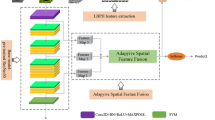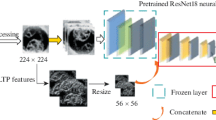Abstract
With the development of theories and technologies in medical imaging, most of the tumors can be detected in the early stage. However, the nature of ovarian cysts lacks accurate judgement, leading to that many patients with benign nodules still need Fine Needle Aspiration (FNA) biopsies or surgeries, increasing the physical pain and mental pressure of patients as well as unnecessary medical health care costs. Therefore, we present an image diagnosis system for classifying the ovarian cysts in color ultrasound images, which novelly applies the image features fused by both high-level features from deep learning network and low-level features from texture descriptor. Firstly, the ultrasound images are enhanced to improve the quality of training data set and the rotation invariant uniform local binary pattern (ULBP) features are extracted from each of the images as the low-level texture features. Then the high-level deep features extracted by the fine-tuned GoogLeNet neural network and the low-level ULBP features are normalized and cascaded as one fusion feature that can represent both the semantic context and the texture patterns distributed in the image. Finally, the fusion features are input to the Cost-sensitive Random Forest classifier to classify the images into “malignant” and “benign”. The high-level features extracted by the deep neural network from the medical ultrasound image can reflect the visual features of the lesion region, while the low-level texture features can describe the edges, direction and distribution of intensities. Experimental results indicate that the combination of the two types of features can describe the differences between the lesion regions and other regions, and the differences between lesions regions of malignant and benign ovarian cysts.




Similar content being viewed by others
Change history
11 February 2023
This article has been retracted. Please see the Retraction Notice for more detail: https://doi.org/10.1007/s10916-023-01915-6
References
Sadowski, E. A. et al., A systematic approach to adnexal masses discovered on ultrasound: the ADNEx MR scoring system. Abdominal Radiology 43(3):679–695, 2018.
Faust, O. et al., Comparative assessment of texture features for the identification of cancer in ultrasound images: a review. Biocybernetics and Biomedical Engineering 38(2):275–296, 2018.
Perera, R. et al., Ultrasound contrast agents and delivery systems in cancer detection and therapy. Advances in Cancer Research 139. Academic Press:57–84, 2018.
Lusk, J. F., et al. Photoacoustic Flow System for the Detection of Ovarian Circulating Tumor Cells Utilizing Copper Sulfide Nanoparticles. ACS Biomaterials Science & Engineering, (2019).
Kam, H. J., Kim, H. Y., Learning representations for the early detection of sepsis with deep neural networks[J]. Computers in Biology and Medicine, S0010482517302743, 2017.
Luo, B., Wang, H., Liu, H., et al. Early Fault Detection of Machine Tools Based on Deep Learning and Dynamic Identification[J]. IEEE Transactions on Industrial Electronics, PP(99):1-1, (2018).
Ghatwary, N., Zolgharni, M., Ye, X., Early esophageal adenocarcinoma detection using deep learning methods[J]. International Journal of Computer Assisted Radiology and Surgery, (3):1-11, (2019).
Lee, Y.-B., Choi, Y.-J., and Kim, M.-H., Boundary detection in carotid ultrasound images using dynamic programming and a directional Haar-like filter. Comput. Biol. Med. 40(8):687–697, 2010.
Menchón-Lara, R-M., Sancho-Gómez, J-L., Bueno-Crespo, A., Early-stage atherosclerosis detection using deep learning over carotid ultrasound images[M]. Elsevier Science Publishers B. V. (2016).
Chen, S. J., Chang, C. Y., Chang, K. Y. et al., Classification of the thyroid nodules based on characteristic sonographic textural feature and correlated histopathology using hierarchical support vector Machines[J]. Ultrasound in Medicine and Biology 36(12):2018–2026, 2010.
Chang, C. Y., Liu, H. Y., Tseng, C. H. et al., Computer-aided diagnosis for thyroid graves’disease in ultrasound images[J]. Biomedical Engineering: Applications, Basis and Communications 22(2):91–99, 2010.
Katsigiannis, S., Keramidas, E. G., and Maroulis, D., A contourlet transform feature extraction scheme for ultrasound thyroid texture classification[J]. International Journal of Engineering Intelligent Systems for Electrical Engineering and Communications 18(3-4):171, 2010.
Acharya, U. R., Sree, S. V., Swapna, G. et al., Effect of complex wavelet transform filter on thyroid tumor classification in three-dimensional ultrasound[J]. Proceedings of the Institution of Mechanical Engineers, Part H: Journal of Engineering in Medicine 227(3):284–292, 2013.
Iakovidis, D. K., Keramidas, E. G., Maroulis, D., Fuzzy local binary patterns for ultrasound texture characterization[C]//Proceedings of the 5th International Conference on Image Analysis and Recognition. Póvoa de Varzim, Portugal: Springer, 750-759, (2008).
Chang, C. Y., Chen, S. J., and Tsai, M. F., Application of support-vectormachine-based method for feature selection and classification of thyroid nodules in ultrasound images[J]. Pattern Recognition 43(10):3494–3506, 2010.
Acharya, U. R., Swapna, G., Sree, S. V. et al., A review on ultrasoundbased thyroid cancer tissue characterization and automated classification[J]. Technology in Cancer Research and Treatment 13(4):289–301, 2014.
Ma, S., Sigal, L., Sclaroff, S., Learning Activity Progression in LSTMs for Activity Detection and Early Detection[C]// 2016 IEEE Conference on Computer Vision and Pattern Recognition (CVPR). IEEE, (2016).
Costa, A. C., Oliveira, H. C. R., Catani, J. H., et al. Data Augmentation for Detection of Architectural Distortion in Digital Mammography using Deep Learning Approach[J]. (2018).
Aliamiri, A., Shen, Y., Deep learning based atrial fibrillation detection using wearable photoplethysmography sensor[C]// IEEE Embs International Conference on Biomedical & Health Informatics. IEEE, 442-445, (2018).
Liang, Q., Wendelhag, I., Wikstrand, J., and Gustavsson, T., A multiscale dynamic programming procedure for boundary detection in ultrasonic artery images. IEEE Trans. Med. Imaging 19(2):127–142, 2000.
Krizhevsky, A., Sutskever, I., Hinton, G. E., ImageNet classification with deep convolutional neural networks[C]//Proceedings of the 25th International Conference on Neural Information Processing Systems. Lake Tahoe, Nevada: Curran Associates Inc., 1097-1105, (2012)
Roth, R. H., Lu, L., Seff, A., et al. A new 2. 5D representation for lymph node detection using random sets of deep convolutional neural network observations[C]//Proceedings of the 17th International Conference on Medical Image Computing and ComputerAssisted Intervention. Boston, MA, USA: Springer, 520-527, (2014).
Menchón-Lara, R-M., Sancho-Gómez, J-L., Bueno-Crespo, A., Early-stage atherosclerosis detection using deep learning over carotid ultrasound images[J]. Applied Soft Computing, S1568494616304574, (2016).
Spanhol, F. A., Oliveira, L. S., Petitjean, C., et al. Breast cancer histopathological image classification using convolutional neural networks[C]//Proceedings of 2016 International Joint Conference on Neural Networks. Vancouver, BC, Canada: IEEE, 2560-2567, (2016).
Li, W., Cao, P., Zhao, D. Z., et al. Pulmonary nodule classification with deep convolutional neural networks on computed tomography images[J]. Computational and Mathematical Methods in Medicine, 2016: #6215085, (2016).
Bengio, Y., Courville, A., and Vincent, P., Representation learning: a review and new perspectives. IEEE Trans. Pattern Anal. Mach. Intell. 35(8):1798–1828, 2013. https://doi.org/10.1109/TPAMI.2013.50.
Loizou, C. P., Pattichis, C. S., Pantziaris, M., Tyllis, T., and Nicolaides, A., Snakes based segmentation of the common carotid artery intima media. Med. Biol. Eng. Comput. 45(1):35–49, 2007.
Cheng, D.-C., and Jiang, X., Detections of arterial wall in sonographic artery images using dual dynamic programming. IEEE Trans. Inf. Technol. Biomed. 12(6):792–799, 2008.
Xu, X., Zhou, Y., Cheng, X., Song, E., and Li, G., Ultrasound intima-media segmentation using though transform and dual snake model. Comput. Med. Imaging Graph. 36(3):248–258, 2012.
Huang, G.-B., Zhu, Q.-Y., and Siew, C.-K., Extreme learning machine: theory and applications. Neurocomputing 70(1–3):489–501, 2006. https://doi.org/10.1016/j.neucom.2005.12.126.
Deng, L., Yu, D. Deep learning: methods and applications[J]. Foundations & Trends in Signal Processing, 2014, 7(3):197–387.
Kasun, L. L. C., Zhou, H., Huang, G.-B., and Vong, C. M., Representational learning with extreme learning machine for big data. IEEE Intell. Syst. 28(6):31–34, 2013.
W. Zong, G. B. Huang, Y. Chen, Weighted extreme learning machine for imbalance learning, Neurocomputing 1:24.
Santhiyakumari, N., and Madheswaran, M., Non-invasive evaluation of carotid artery wall thickness using improved dynamic programming technique. Signal Image Video Process. 2(2):183–193, 2008.
Huang, G.-B., Zhou, H., Ding, X., and Zhang, R., Extreme learning machine for regression and multiclass classification. IEEE Trans. Syst. Man Cybern. Part B: Cybern. 42(2):513–529, 2012. https://doi.org/10.1109/TSMCB.2011.2168604.
Molinari, F., Meiburger, K. M., Saba, L., Acharya, U. R., Ledda, M., Nicolaides, A., and Suri, J. S., Constrained snake vs. conventional snake for carotid ultrasound automated IMT measurements on multi-center data sets. Ultrasonics 52(7):949–961, 2012.
Author information
Authors and Affiliations
Corresponding author
Ethics declarations
Conflict of interest
We declare that we have no conflict of interest.
Human and Animal Rights
This article does not contain any studies with human participants or animals performed by any of the authors.
Informed consent
Informed consent was obtained from all individual participants included in the study.
Additional information
Publisher’s Note
Springer Nature remains neutral with regard to jurisdictional claims in published maps and institutional affiliations.
This article is part of the Topical Collection on Image & Signal Processing
About this article
Cite this article
Zhang, L., Huang, J. & Liu, L. RETRACTED ARTICLE: Improved Deep Learning Network Based in combination with Cost-sensitive Learning for Early Detection of Ovarian Cancer in Color Ultrasound Detecting System. J Med Syst 43, 251 (2019). https://doi.org/10.1007/s10916-019-1356-8
Received:
Accepted:
Published:
DOI: https://doi.org/10.1007/s10916-019-1356-8




